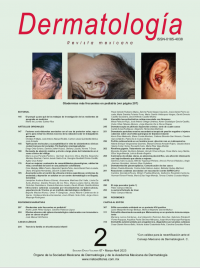Acne in women: evaluation of gynecologic comorbidities, quality of life and acne severity in a Colombian population.
Dermatol Rev Mex. 2023; 67 (2): 176-184. https://doi.org/10.24245/drm/bmu.v67i2.8744
Criss Madeley Millán-Puerto, Alejandra Fajardo-Peña, Jesús Daniel Fierro-Lozada, Diana M Espitia-Hernández, David A Castillo-Molina
Fundación para la Investigación en Dermatología (Funinderma).
Resumen
OBJETIVO: Caracterizar clínica y epidemiológicamente una población femenina con diagnóstico de acné.
MATERIALES Y MÉTODOS: Estudio observacional retrospectivo en el que evaluamos pacientes femeninas con diagnóstico de acné atendidas en un centro dermatológico en Bogotá, Colombia, de junio a octubre de 2021. Se evaluó la historia clínica y factores demográficos. Se aplicó la herramienta del sistema de clasificación global del acné (GAGS) y el índice de calidad de vida dermatológica (DLQI). Se aplicó la prueba χ2 de independencia.
RESULTADOS: Se analizaron 251 pacientes. La mediana de la edad fue de 21 años, el nivel de gravedad predominante fue leve y la mayoría de las pacientes tuvieron una afectación leve en la calidad de vida. Las áreas con mayor afectación fueron la frente, la nariz, las mejillas y la región submandibular. El 43% de las pacientes que tenían antecedentes ginecológicos reportaron tener ciclo menstrual irregular y el 7.5% tenían diagnóstico de síndrome ovario poliquístico confirmado. Cuatro de cada 5 pacientes tenían antecedente de acné durante la adolescencia. Los principales factores desencadenantes fueron el estrés y la menstruación. Se evidenció asociación significativa entre la clasificación GAGS, DLQI, el uso de cubrebocas, el síndrome ovario poliquístico y el estrés.
CONCLUSIONES: El acné en la mujer es una afección que debe evaluarse y tratarse desde otra perspectiva teniendo en cuenta la influencia fisiopatológica de los factores endocrinos y componentes ginecológicos.
PALABRAS CLAVE: Mujeres; acné vulgar; calidad de vida; irregularidad menstrual; síndrome de ovario poliquístico.
Abstract
OBJECTIVE: To characterize clinically and epidemiologically a female population diagnosed with acne.
MATERIALS AND METHODS: A retrospective observational study was performed at a dermatological center in Bogota, Colombia, from June to October 2021. We evaluated female patients with a diagnosis of acne. The clinical history and demographic factors were evaluated. The Global Acne Grading System (GAGS) tool and the Dermatology Life Quality Index (DLQI) were applied. The χ2 test of independence was applied.
RESULTS: A total of 251 patients were analyzed. The median age was 21 years, the predominant level of severity was mild, and most patients had mild impairment in quality of life. The areas with the greatest involvement were forehead, nose, cheeks and submandibular region. Forty-three percent of the patients with a gynecologic history reported having an irregular menstrual cycle and 7.5% had a confirmed diagnosis of polycystic ovary syndrome. Four out of 5 patients had a history of acne during adolescence. The main triggering factors were stress and menstruation. There was a significant association between the GAGS classification, DLQI, the use of a face mask, as well as polycystic ovary syndrome and stress.
CONCLUSIONS: Acne in women is an entity that should be evaluated and treated from a different perspective taking into account the pathophysiological influence of endocrine and gynecological components.
KEYWORDS: Women; Acne vulgaris; Quality of life; Menstruation disturbances; Polycystic ovary syndrome.
Recibido: octubre 2022
Aceptado: noviembre 2022
Este artículo debe citarse como: Millán-Puerto CM, Fajardo-Peña A, Fierro-Lozada JD, Espitia-Hernández DM, Castillo-Molina DA. Acné en mujeres: evaluación de comorbilidades ginecológicas, calidad de vida y severidad del acné en una población colombiana. Dermatol Rev Mex 2023; 67 (2): 176-184.

